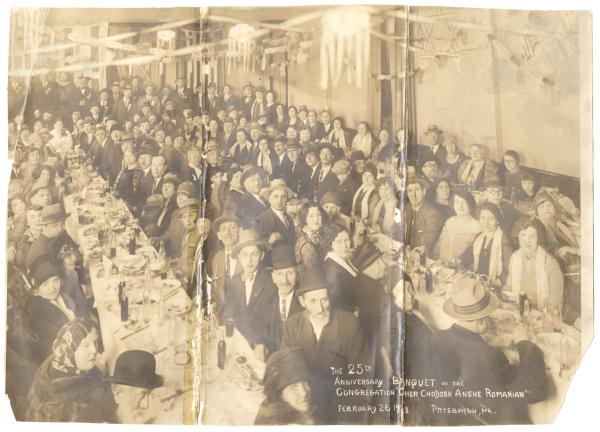

New Light Congregation emerged from a wave of Romanian Jewish immigration to Pittsburgh in the 1890s, the result of increased antisemitism in Romania. A group of these immigrants chartered Congregation Ohel Jacob (“Tent of Jacob”) in the Hill District in December 1899.
Within a few years, increased Jewish emigration from Romania made Ohel Jacob one of the largest Jewish congregations in the neighborhood, with several hundred members. Ohel Jacob dedicated a two-story brick synagogue on Roberts Street in September 1903 at a cost of some $25,000 and hired Rabbi Moshe Shimon Sivitz to serve as its part-time spiritual leader. Based on various photographs of the neighborhood, the design of the Roberts Street synagogue appears to have been identical to the design of the Shaaray Tefillah synagogue built one street over on Miller Street in 1905.
Toward the end of 1903, shortly after the dedication of the Roberts Street synagogue, a group within Ohel Jacob broke away to create Kneseth Israel (“Gathering of Israel”). Kneseth Israel later acquired a synagogue on Miller Street. For many years, New Light was known as the “big Romanian shul,” while Kneseth Israel was known as the “little Romanian shul.” A second breakaway Romanian congregation called Shaare Shamayim Anshe Rumanian later merged back into New Light.
Through a new charter obtained in October 1909, Ohel Jacob changed its named to Oir Hudish. The congregation used various spellings over the years—including Ohr Chodesh, Oher Chodesh and Or Chodesh—before shifting to English: New Light Congregation.
Ohel Jacob/New Light acquired cemetery property in Shaler Township in 1904. Among the notable people buried in the cemetery are Mayor Sophie Masloff and developer and Yiddish theater promoter William Lando.
Throughout the early decades of the 20th century, New Light Congregation served as a central meeting place for Jewish immigrants from Romania. It brought many notable cantors to Pittsburgh, and it hosted auxiliaries such as the Romanian Ladies Aid Society and the Roumanian Lebanon Society.
By the mid-1950s, the membership of New Light Congregation largely lived outside of the Hill District, although regular services continued at the Roberts Street synagogue. The congregation sold the building to the New Canaan Baptist Church in 1955 and donated several of its Torah scrolls to the new Parkway Jewish Center in Monroeville. New Light acquired a house at the corner of Forbes Avenue and Beechwood Boulevard in Squirrel Hill in 1957 and converted it into a synagogue. It added a sanctuary to the building in 1970. The congregation sold the building to Chabad of Pittsburgh in 2017 and moved into the basement of the Tree of Life synagogue at the corner of Shady and Wilkins avenues.
Although founded as an Orthodox congregation, New Light gradually liberalized its service over the years. With the move to Squirrel Hill, it formally affiliated with the Conservative movement, created a Men’s Club, and transitioned its women’s auxiliary into a Sisterhood. It also began using the English name New Light. It eventually became fully egalitarian, including women and men in all aspects of its service.
Presidents of New Light include Julius Sand (1901-1903), Barish Chaimovitz (1903-1905), Sol Liebling (1905-?), Charles Barofsky, Abraham Lebovitz, Israel Rosenfeld, Dr. Sam Weisberg, Lewis Hendel (1919), B. Horovitz (1922), William Lando (1924), Irving Sand (1925), M. Kohen (1931-1932, 1938-1939), Abe Moskowitz (1949), Dr. Bernard Shepman (1964-1965), Jacob M. Stone (1971-1973), Charles M. Elovitz (1973-1975), David M. Maretsky (1975-1976), Nathan E. Landy (1976-1977), Walter Reisz (1978-1979), Howard Kubitz (1980-1982), Milton Lewinter (1982-1984), Rachel Reisz (1984-1985), Melvin Wax (1985-1986), Martin Scoratow (1986-1988), Marc Jampole (1990-1991), Renee Scoratow (1991-1992, 1995), Richard Gottfried (1993-1995), Marilyn Honigsberg (1993-1995, 2012-2016), Barbara L. Caplan (1996-1999), Helene Harris (1996-1999, 2007-2012), Marvin Feldman (1999-2001), Dan Stein (2002-2005), Arnold Berger (2005-2007), Karen Coburn (2009-2011), Marilyn Honisberg and Barbara Caplan (2011-2015), Stephen Cohen and Barbara Caplan (2016-present).
Spiritual leaders of New Light Congregation include Rabbi Moshe Shimon Sivitz, Rabbi Wolf Leiter, Rabbi Pincus Miller (1966-1976), Rabbi Stanley Savage (1977-1986), Rabbi Paul Reis, Rabbi David Lazar (1986-1995), Rabbi Gershon Freidlin (1995-1997), Rabbi Harvey Brotsky (1998-2009) and Rabbi Jonathan Perlman (2010-).
